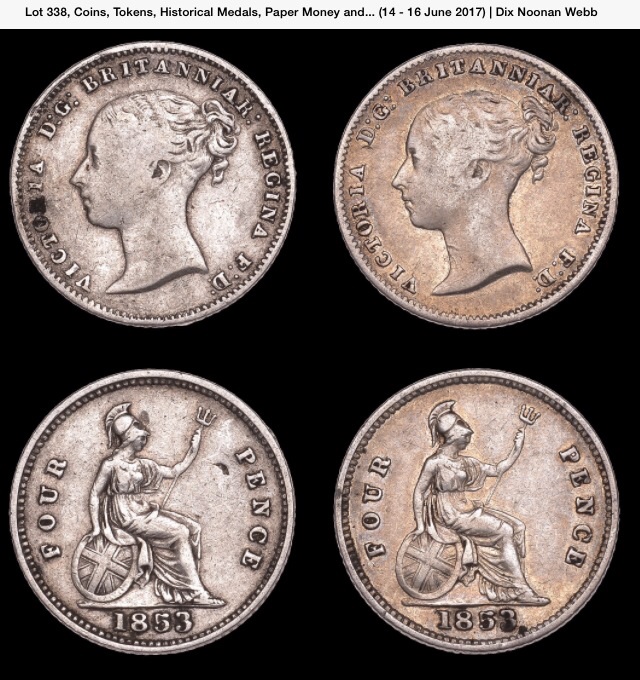-
Posts
511 -
Joined
-
Last visited
-
Days Won
30
Content Type
Profiles
Forums
Events
Downloads
Store
Gallery
Articles
Everything posted by Martinminerva
-

Green Victoria
Martinminerva replied to Gaz T's topic in British Coin Related Discussions & Enquiries
It is die pair 7+H from Freeman's book, with the H under date for a Heaton mint. One of the most common pairs, I'm afraid... -
This is an example of a fairly common mint mis-strike: the blank from which the coin is struck has not fully settled into the collar that locates it between the dies (and which being grooved, also imparts the milling to the edge as the coin is squeezed between the dies). As such the bit of the blank that protrudes not only misses out on the milling, but can also "overflow" wider than the rest of the coin when pressure is applied with no collar to retain it, which sounds exactly like your description in the original post. An interesting curiosity, but of no real value, I'm afraid, but hope it helps answer your question.
-

1860 F9 Penny ?? TB/BB mule
Martinminerva replied to mick1271's topic in British Coin Related Discussions & Enquiries
It certainly is a mule, and in addition it is in smashing condition. Just shows that there are more of these rarities out there somewhere! Nice find! -

1836 Threepenny Bit Victoria
Martinminerva replied to sgpowelluk's topic in British Coin Related Discussions & Enquiries
I agree. The more numerous and smaller border beads on the reverse proves it has to date post-1866, according to the Davies die identifiers in his British Silver Coins book, plus the obverse too has to be a later type as it is in lower relief. I suspect either accidental damage or else someone "tinkering" with the date to produce a curiosity.- 8 replies
-
- threepenny
- victoria
-
(and 1 more)
Tagged with:
-

KING GEORGE THE IIII 1822
Martinminerva replied to scotsman's topic in British Coin Related Discussions & Enquiries
I agree. With the various edge and dig problems, it's only a Good Fine for me - albeit a nice colour. But it is certainly genuine. Value though only £100 tops for me; if you've got two hundred spare, you could get a much nicer one, I feel. -

George IV Crown - Chinese fakes
Martinminerva replied to seuk's topic in British Coin Related Discussions & Enquiries
Good idea, but a seller has the choice about whether to publish enquiries on their listing or not - it is not automatic, so unfortunately a dodgy seller won't of course pay any attention to such queries. -

1837 sixpence B over R in BRITANNIAR
Martinminerva replied to Nick's topic in Confirmed unlisted Varieties.
A low grade one of these has just been listed on eBay, item number 282570051312 It does seem to be a very rare variety; I have only seen a couple myself. -

1848 Groat obverse G over sideways G
Martinminerva replied to Rob's topic in Confirmed unlisted Varieties.
I disagree! Given it is only recorded thus far in the Coincraft catalogue (and I don't think that has been printed for over a decade now!!), leaving it on here is a better way of recording it until it gets taken on board by eg. Spink, ESC, Collectors Coins of GB or wherever! Good to spread knowledge! -

1848 Groat obverse G over sideways G
Martinminerva replied to Rob's topic in Confirmed unlisted Varieties.
Have now found the one on the DNW archive, and post pics below. This too is actually the small date reverse. It is not the overdate, but there is a trace of doubling at the top of the 8. Checking out my own examples, they are all of the same reverse die, with the trace of doubling, so not a new variety but one that I have only seen recorded in Coincraft, and only a handful at that. Perhaps now it should be recorded more mainstream?? -

1848 Groat obverse G over sideways G
Martinminerva replied to Rob's topic in Confirmed unlisted Varieties.
Gets a mention in the Coincraft catalogue, but doesn't distinguish reverse dies. I myself have a couple of these, and have seen three more, and all were paired with the 1848 plain, SMALL date. Haven't seen one paired with the large date and/or the overdate reverses. Does DNW not have a picture of the reverse die for their specimen? -
They are gothic font v's, not b's, but with the ornate script, the large serifs on the font, and with flattening caused by wear they can look a bit like b's to the untrained eye. There are no variants of these two dates apart from various die numbers - tiny little numbers - below Victorias's bust on the 1875 piece, and so no additional rarity values. Have a trawl of eBay and you'll see exactly what I mean about the font style and the v's getting flattened to look like b's. Sorry to be the bearer of bad news, but hope it helps...
-
I have also now come across one of these with the small inverted 8 over a normal upright 8 (and forked tail to 6), but in pretty decent condition. Are they recorded anywhere? Not on aboutfarthings.com, I see... How rare are they, or indeed how worthy of note?
-
Think I am now getting somewhere: have been directed to this part of the Royal Mint website (below). These would appear to be the samples issued to the coin operated equipment industry so as to prepare for the changeover. But they are not being released to mere mortals, and reference to "terms and conditions" makes me think that they don't want them getting out to the general public, though clearly they are! Anyone on here actually got one? I wouldn't mind one just as a curiosity!
-
Here's a few other photos of similar pieces culled from eBay in better resolution. They do seem very believable, especially the obverse with the micro lettering of ONE POUND in the sloping angles, which I have read about somewhere is going to be a security feature. Has anyone on the forum got / bought one, or can offer further information? I find it curious these have started appearing but there is nothing about them on the net... All I have seen is George Osbourne (remember him?!) holding a trial piece up for the cameras when the forthcoming new shape pound was first announced in the press a couple of years ago, and it does look like the same design. I am very suspicious that these may not be the real deal, but intrigued at the same time.
-
Ok - so what's the story behind these? They have been cropping up now on eBay and the like for a month or so, selling in the £200 region, but often with curious statements like "found in my change" or "won in a fruit machine" which makes me suspicious. They look good and 'genuine', but I haven't been able to find any information about them on the net. Where are they originating from? How many are there? Are the Royal Mint selling them off, but if so, how and where? Is there another source?? Or are they very clever replicas/copies? If the latter, then perhaps the real ones to be issued next year are not so counterfeit-proof after all !?
-
Paddy is exactly right! The Battle of Britain coin was issued in sets and folders only initially (last year I think it was), and that was before the change of portrait. The circulation pieces issued more recently all have the new portrait. So it's not an error, but it is a valid variety! Regarding the lines over the face swimming 50p, that too is not strictly an error but a (very rare) first issue before a change of design. The coin once minted proved to be too indistinct, so it was hastily redesigned with the lines removed and then issued in big numbers. Not sure how many first issue rare ones there were released, but certainly doesn't seem to be many. They tend to go for £800 plus.
-
Indeed, the edge writing is put onto decimal blanks first by being squeezed through rollers, then the lettered blanks are hopper fed in a totally separate process into a normal coining press with a plain milled collar. As the letters are incuse, the milling doesn't tend to obliterate the letters, though some metal flow can result in those very common "pemember" type 'errors' with missing serifs and the like. But since they are hopper fed, there is a 50:50 chance as to which way up they land in the coining press! So all those eBay "rarities" are anything but - there will be the same number of each!! Just check out a handful of pocket change, and you'll have examples both ways up. Has anyone actually paid hundreds to an eBay seller for such a coin?? Doesn't it cost them money to list them if they are buy-it-nows? Surely these sellers will soon learn that these coins are worth just a pound! Or two, if it's a two pound coin!! Anyway, welcome indeed - going through change is a great way to start into coin collecting, and then with a bit of reading up on things, including this forum, you'll soon get into the swing of things and start to push your collection back into pre-decimal lines.
-

Victorian 2/6 1843 5/3
Martinminerva replied to sound's topic in British Coin Related Discussions & Enquiries
Can you or anyone post a picture of the 1843 groat with 4 over 5?? I have been looking for one of these for ages, and have never even seen a convincing specimen!! Yet in the catalogues very little premium value is suggested.












